Capital One Arena - Georgetown Hoyas
- Gregory Koch

- Jan 10, 2024
- 6 min read
Updated: Sep 2
Photos by Gregory Koch, Stadium Journey
Capital One Arena FANFARE Score: 2.86
Capital One Arena 601 F St NW Washington, DC 20004
Year Opened: 1997 Capacity: 20,356
Georgetown A-Hoya
The Georgetown Hoyas are one of the most storied programs in college basketball history. With players like Allen Iverson, Dikembe Mutombo, Patrick Ewing, and Alonzo Mourning, the Hoyas dominated the Big East for many years. They have reached five Final Fours, including a national championship victory in 1984.
For many years, the Hoyas played on campus at McDonough Arena but moved off campus to the Capital Centre in Landover, MD in 1981 to accommodate the bigger crowds. McDonough is still home to the Hoyas’ women’s basketball team. In 1997, the Hoyas moved back to the District into what was then called the MCI Center and is today known as Capital One Arena. This arena is also the home of the Washington Wizards of the NBA and the Washington Capitals of the NHL.
Georgetown’s colors are blue and gray and were chosen after the Civil War to promote unity between northern and southern students, many of whom had served in battle for one side or the other. Blue and gray were, of course, the colors of the Union and Confederate military uniforms, respectively.
Food & Beverage 3
Seeing as Capital One Arena is a professional sporting venue, it does have quite a wide selection. However, the flip side of this is that what they have is quite expensive for a college venue. Additionally, many of the stands, including most of the specialty stands, will be closed for most games due to the smaller crowds compared to the Wizards and Capitals. That being said, fans certainly won’t go hungry. Main course selections include cheeseburgers and chicken tenders well as items such as sausage and hot dogs. Snacks include popcorn and hot pretzels.
Drinks include bottled water and fountain soda.. Keep in mind that fountain beverages no longer come with lids or straws at Capital One Arena in an attempt to reduce environmental waste. Since Capital One is an off-campus arena, it is not too surprising that alcohol is available as well.
Prices are very high, as this is a professional arena.
As part of the naming rights deal, all Capital One credit or debit cardholders get a 10 percent discount on concessions throughout the arena, but this does not come off automatically and you must notify the cashier.
Atmosphere 2
Capital One Arena is a perfect example of why bigger isn’t always better. Although the arena seats over 20,000 fans, it is rarely even close to full. Although the Hoyas’ former on-campus home is way too small at only a few thousand seats, it seems like there should be a happy medium somewhere. The arena is far too big and has a tendency to mask the crowd noise from the few thousand fans who show up. That being said, there are no plans to build a new arena on or off campus at any point in the future and the Hoyas seem content with playing at Capital One despite the thousands of empty seats at each home game.
The Hoyas do at least try to keep fans engaged. Before each game, the Hoyas are introduced as spotlights and strobe lights light up the court. These lights continue during all media timeouts, which can get quite annoying, although they do not turn the lights out in the arena except at the beginning.
There is a pep band as well as cheerleaders and a dance team to pump up the crowd, and contests on the court during TV timeouts. The Hoyas’ mascot is a bulldog named Jack, and there is both a costumed version and a real live dog version. The most popular Georgetown chant is “Hoya Saxa,” which literally means something to the effect of “What rocks!” in a combination of Greek and Latin. Fans can expect to hear it several times a game.

Neighborhood 4
Capital One Arena is located in the Chinatown neighborhood of DC, though the area has gentrified significantly since the arena was built. The Greene Turtle is a popular sports bar located right around the corner. while the Gallery Place shopping mall is also right around the corner and includes numerous stores and a movie theater. Unfortunately, a lot of other businesses in the area have closed in recent years, between COVID and rising crime in the area. The neighborhood is still pretty safe despite public perception to the contrary, but you are in a major city so be aware of your surroundings.
Your best entertainment options will involve traveling a bit away from the arena, but not far. That’s because you’re in DC, the nation’s capital, and there’s a lot to do. The best part is that most of it’s free. Whether it’s checking out the many memorials and monuments on and around the National Mall, visiting one of the numerous museums, or simply taking in the historic sights, there’s something for everyone here. All government-run attractions are free to the public, though some private ones are not. Keep in mind, however, that if you wish to tour the Capitol or the White House, you will need to book that in advance.
Fans 2
Georgetown only draws a few thousand fans a game in a 20,000 seat arena, which is not a good look. Gone are the days when the Hoyas dominated college basketball and played before large crowds. The fans who do show up can get loud at times, but there simply aren't that many of them, especially in such a large arena. It is unfortunate to see just how far this fan base has fallen.
Access 3
Capital One Arena is located just steps from the Gallery Place-Chinatown Metro station on the Red, Green, and Yellow lines. While this may seem like an amazing thing, the unfortunate reality is that Metro is difficult at the best of times and unusable at the worst. The last few years have seen numerous construction projects shut down several stations for weeks or even months at a time. Even if one of these isn’t ongoing, there is track work almost every weekend that increases headways on many lines and often closes several additional stations. The result is that there could be 24 minutes or more between trains, and that’s assuming everything functions properly, which it frequently doesn’t. The good news is that even people coming from outside the immediate DC area can take the Metro by parking at one of the suburban stations. Keep in mind that you will need to pay for parking with the same SmarTrip card you paid your fare with or you will be subject to a much higher rate at certain stations.
If you don’t want to chance it with Metro, you can drive to the game. Ample garage parking is available but is costly. The exact cost varies by the day and based on availability, but expect to pay at least $20 and probably much more. You can also take a rideshare such as Uber or Lyft.
Once you’re in the arena, the concourses are wide enough to allow for easy navigation. There can be long lines at concessions or restrooms during halftime, but if you leave as soon as the half ends, you should be back in your seat by the time the game resumes.
Of note, Capital One Arena has a no bag policy. Even clear bags are not allowed, unless they are wallet sized or required for medical reasons. Bags which meet these narrow requirements are allowed whether they are clear or not. This makes things extremely difficult for fans.
Return on Investment 3
The Hoyas use a dynamic pricing method for their tickets, meaning pricing varies based on demand, opponent, and other factors such as the day of the week the game is being played. Good seats can be had for as little as $10 for non-conference games against lower-tier opponents, but if you want to see a top-level Big East school like Villanova, expect to pay at least $30, and possibly over $100 if you want lower-level seats.
If you don’t care who you see the Hoyas play, you can have a chance to watch Big East basketball and get great seats for far less than what a comparable location would cost for other events in the arena. Tickets are still relatively affordable for the bigger games, but you’ll be paying more for worse seats.
All that being said, you can often find better deals on the secondary market, especially closer to game time or if Georgetown is playing a weak opponent.
Concessions are extremely pricey as well, this being an NBA arena and all. When combined with the mediocre fan experience, a Georgetown basketball game is average value at best.
Extras 2
A team store is located on the 100-level concourse and sells Georgetown gear.
:The pregame introductions, with spotlights illuminating the court, are impressive, though the continued use of light shows during all media timeouts gets irritating.
Final Thoughts
The Georgetown basketball program has fallen on hard times in recent years. Attendance is down, performance on the court is down, and this has all contributed to significantly reduce the quality of the fan experience here. Georgetown plays its home games in a cavernous arena that is mostly empty for the typical game, and that is simply not conducive to a good fan experience.













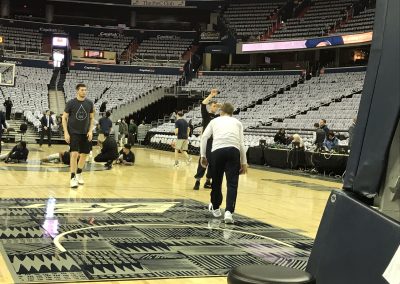



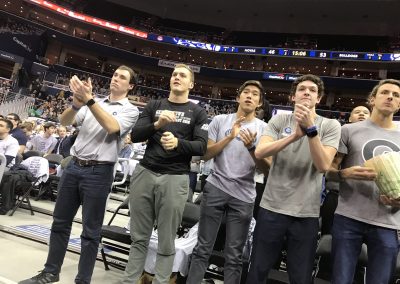



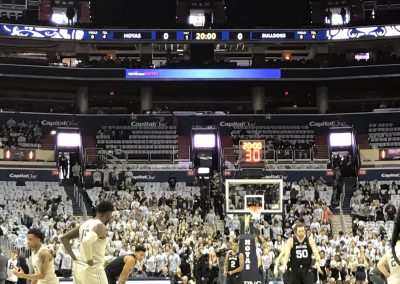

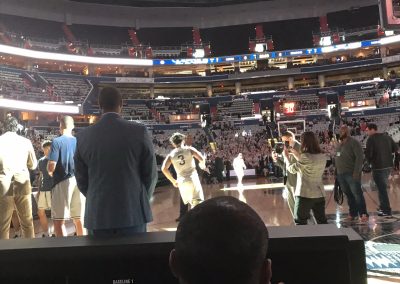

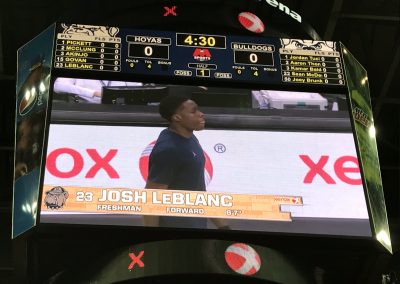

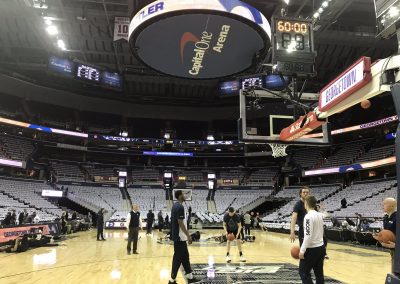

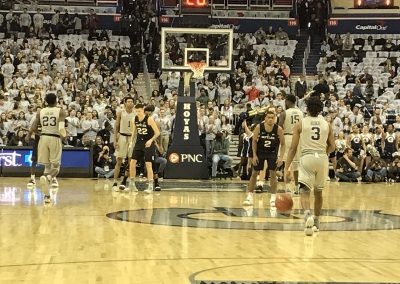









Comments